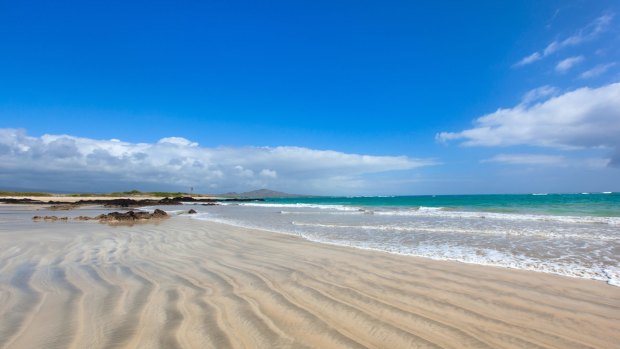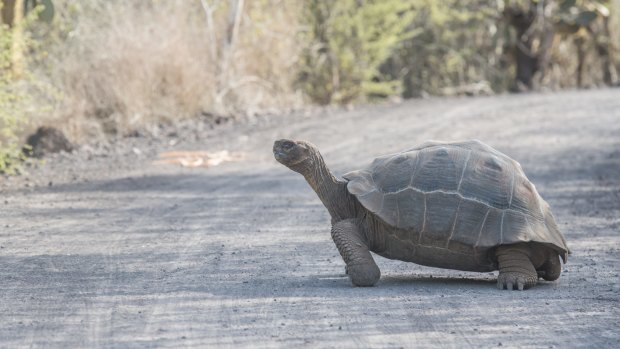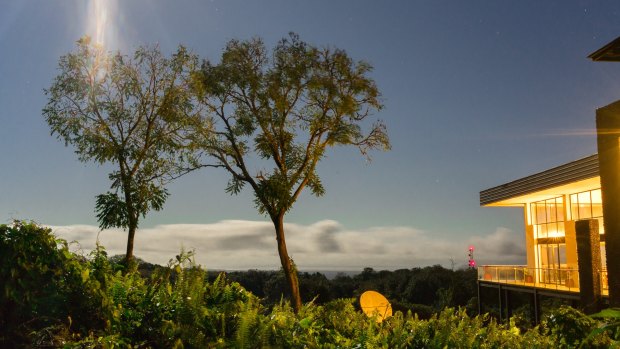This was published 4 years ago
Galapagos Islands Ecuador: Land-based programs are the new way to see the wonders of the Galapagos
By Rob McFarland

Most visitors to the Galapagos explore via boat. But restrictions on the number of vessels have made land-based programs increasingly popular.Credit: Scalesia Lodge
"Just relax," says Carlos, our snorkelling guide. Easier said than done when you're about to be plunged into a cave full of sharks. I take a deep breath and he guides me underwater into a murky, sand-bottomed hollow where I come face-to-fin with a dozen whitetip reef sharks. Most are lying motionless on the bottom (whitetips are one of the few sharks that don't need to swim to breathe) but two are circling ominously. Thankfully, they're harmless, unlike their more aggressive oceanic cousins.
After 10 seconds I motion to come back up and we both return, grinning, to the surface. He turns to the rest of the group. "OK, who's next?" We're snorkelling in a shallow protected lagoon on the south coast of Isabela Island in the Galapagos Islands, 1000 kilometres west of mainland Ecuador. So far, we've seen two sea turtles perform a mesmerising underwater ballet, watched a Pacific seahorse skip daintily along the seabed and spotted colourful damselfish, sergeant majors and parrotfish.
Impressive as all these creatures are, none are on the Galapagos' Big 15. Like Africa's Big Five, this is a list of the 15 most iconic animals and birds you can see across the archipelago. Few things fire up the competitive juices like a bucket list and it has already spawned some good-natured rivalry among our group. We've been told Isabela is home to 12 of the 15, so from now on it's all eyes peeled.

The island's Giant Tortoise Breeding Centre has successfully re-introduced more than 2000 tortoises back into the wild.Credit: Andrew Coleman
We clamber back into the boat and cruise along the coast to Los Tuneles, a labyrinthine network of lava tunnels and arches. En route we have our first Big 15 encounter – two Galapagos fur seals basking on a rocky outcrop. As Carlos threads the boat through the narrow channels, we pass a pair of noisy Galapagos sea lions (number two) and after clambering onto the maze of solidified lava, see two blue-footed boobies (number three). As their name suggests, these marine birds have striking baby-blue feet, which they show off during a comical foot-tapping mating dance. By comparison, the grey feet of the Nazca booby are downright drab, but we don't mind because a sighting on the way home brings our Big 15 tally to four. Not bad for a morning's work.
Most visitors explore the Galapagos on an expedition-style cruise ship or sailing boat. However, restrictions on the number of vessels allowed in the region have made land-based programs increasingly popular. They make a compelling alternative for those who need more flexibility in terms of timing and for anyone whose sea legs are a little shaky.
You can find accommodation of varying standards on all four of the inhabited Galapagos Islands, which introduces the intriguing possibility of an island-hopping adventure. We started our trip with a night at the award-winning Finch Bay hotel on Santa Cruz Island before a scenic 30-minute flight delivered us to Isabela and the stylish embrace of Scalesia Lodge.

The stylish Scalesia Lodge.Credit: Misha Vallejo
Set on 16 hectares of verdant forest in the south of the island, Scalesia has spacious safari-style glamping tents with large outdoor decks and modern ensuite bathrooms. All meals are taken in the main lodge, a contemporary two-storey building with sweeping ocean views.
For two days we use the lodge as a base for excursions to see the island's extraordinary array of wildlife. Isabela has more giant tortoises than anywhere else in the Galapagos and we have our fifth Big 15 encounter at the island's Giant Tortoise Breeding Centre. The operation has successfully re-introduced more than 2000 tortoises into the wild and we spend an enjoyable hour wandering between pens watching youngsters clambering over each other to feed, their long necks darting in and out of their shells like sock puppets.
Back at the coast, we visit a wetland that's a popular hangout for American flamingos (number six), flightless cormorants (seven) and marine iguanas (eight). These grizzled, prehistoric-looking reptiles spend the day basking on the boardwalks before heading back to the ocean to feed. Like most of the wildlife in the Galapagos, they are wilfully oblivious to our presence and we frequently have to step over them to get past.
Land-based tourism on Isabela is relatively new compared with neighbouring Santa Cruz and this is reflected in the laidback vibe of its main town Puerto Villamil. Fronting a glorious arc of sandy beach, it's a relaxed hamlet with a smattering of backpackers, restaurants and tour operators. While we're all admiring the sunset, Sandra, our eagle-eyed guide, spots a pair of frigatebirds soaring high above us. Tick. Nine down, six to go.
After each excursion, we return to the lodge where we're greeted with cold towels, freshly squeezed juice and platters of homemade empanadas. Most guests stay with full board and the food is an unexpected highlight. Breakfasts include traditional Ecuadorian dishes such as fried plantain with bacon and cheese while lunches and dinners are feasts of ceviche, swordfish and lobster.
On our last day, Sandra informs us that the most elusive of the Big 15 is the Galapagos hawk. Only a few have been spotted in Sierra Negra, the shield volcano 15 kilometres east of the lodge, so we start the 1200-metre trek to its summit with low expectations. Five of Isabela's six volcanoes are active but Sierra Negra is by far the friskiest. The last major eruption was in June 2018 when lava poured into the ocean from five separate fissures, creating 1.3 kilometres of new land.
It's only when we reach the edge of the caldera that we understand why sightings are so rare. Not only is the volcano almost permanently cloaked in swirling mist, but the caldera is the world's second largest, a whopping 10 kilometres in circumference. Needless to say, we don't spot any hawks but we're consoled by dramatic views into the volcano's black, lava-filled interior.
Purists may claim the Galapagos' Big 15 is just another example of tick-a-box tourism, but it's a fun concept and a great way to engage younger travellers. In two days, we spot a respectable nine, which means we have at least six reasons to come back.
FIVE MORE GALAPAGOS STAYS
FINCH BAY
This National Geographic Unique Lodge of the World is the only beachfront property in Puerto Ayora on Santa Cruz Island and has an extensive program of land- and sea-based excursions. See finchbayhotel.com
GOLDEN BAY HOTEL
This 21-room oceanfront resort on San Cristobel Island is conveniently located a few minutes' walk from the town of Puerto Baquerizo Moreno. See goldenbay.com.ec
GALAPAGOS SAFARI CAMP
Set on a 55-hectare working farm, this family-owned tented camp on Santa Cruz Island has a pool, a kids' club and a trampoline. See galapagossafaricamp.com
FLOREANA LAVA LODGE
This basic 10-cabin beachfront property is located on Floreana Island, the smallest and least populated of the inhabited Galapagos Islands. Contact info@floreanalavalodge.com
GALAPAGOS HABITAT
This recently renovated 17-room hotel in Puerto Ayora on Santa Cruz provides convenient access to a nearby mangrove system. See galapagoshabitat.com
TRIP NOTES
MORE
STAY
A two-night stay at Scalesia Lodge including accommodation, meals and activities starts from $US1139. See scalesialodge.com
TOUR
Latin America specialist Chimu Adventures can devise tailor-made Ecuador itineraries, including flights, accommodation, transfers and tours. Phone 1300 784 286; see chimuadventures.com
Rob McFarland was a guest of Chimu Adventures.
Sign up for the Traveller Deals newsletter
Get exclusive travel deals delivered straight to your inbox. Sign up now.